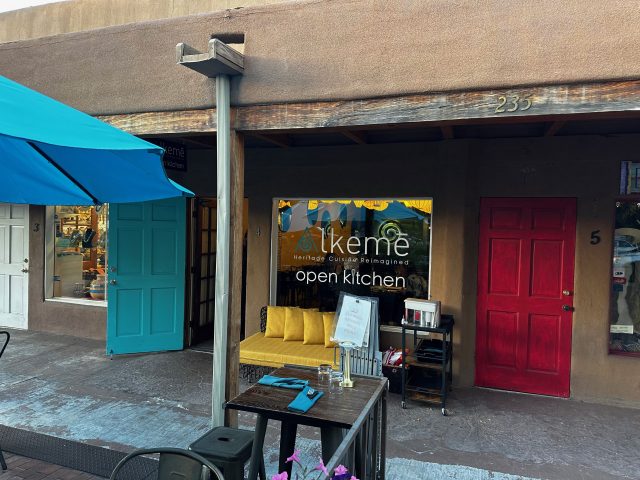
“And the selfsame well from which your laughter rises was oftentimes filled with your tears.
And how else can it be?
The deeper that sorrow carves into your being, the more joy you can contain.”
~Khalil Gibran, The Prophet
Very few of us can identify with the profundity of Khalil Gibran’s immortal poem “On Joy and Sorrow” as well as Hue-Chan Karels, owner of the Santa Fe restaurant that is reimagining Asian cuisine. Outwardly the beautiful entrepreneur is as buoyant and joyful as can be. In fact, what might be her restaurant’s “mission statement” reflects that joy: “We are joy makers who believe in the magic of culinary experiences. Our passion is to create and curate inspired, original, unforgettable gatherings for the joyful celebration of human connection wherever they can be imagined.” Before she became a joy maker, however, she had to surmount deep sorrows that carved into her being.
Hue-Chan was nine years old when she and her family fled Vietnam. Carrying only a small shoulder bag with $500, personal documents and negatives of family photos, the displaced family was sent to Guam then Camp Pendleton, California before relocating to Michigan. From a child’s perspective, the family’s plight was a mix of excitement and trepidation. War-ravaged Vietnam was the only home she had ever known and she didn’t speak or understand English. She had to grow up quickly taking care of her brothers, doing the laundry and standing in line for food.

At age 27, Hue-Chan created a company called Viet-link, a consulting, foreign trade business to help rebuild Vietnam, a challenge exacerbated because the nascent government didn’t have the legal or fiscal systems in place to help her help them. It was a harrowing challenge that sapped her time and energy. She spent the next twenty years as a project manager where she consulted on FDA regulatory compliance. In 2007, Hue-Chan left the corporate world to start an artisan cookie business in Washington, D.C. Within 2.5 years, this grew into Open Kitchen’s unique, multi-purpose concept. Essentially she created spaces where entrepreneurial culinary entrepreneurs–from bakers to caterers– could rent a beautiful kitchen space.
In 2014, Hue-Chan and her husband closed Open Kitchen in Washington and moved to Santa Fe where she reimagined the concept altogether. Her goal has always been to find new and creative ways to build and connect community through the celebration of great food. To that end, she defines Open Kitchen as a “unique culinary concept that celebrates the kitchen as the center of sensory pleasure, healthy living, community, learning and creativity. In the Spring of 2023, she acquired a space in the Santa Fe Village Mall a block south of the Santa Fe Plaza. The space includes three private rooms in which dinners are hosted and cooking classes are held. That space is the home of Alkemē, the hottest ticket in town.
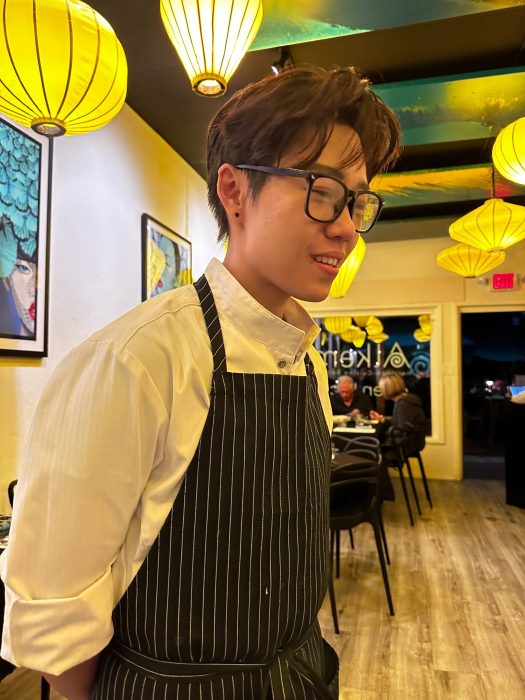
Executive Chef and General Manager Erica Tai is the medium through which Hue-Chan’s vision for unique menu showcasing Pan-ethnic cuisine is realized. Erica’s background in Pan-ethnic cuisine makes her superbly qualified to interpret that vision. Her talent makes her THE best person to do so. Originally from Taiwan and of Taiwanese-Korean descent, she lived in Hawaii before relocating to New Mexico. In 2020 she achieved a Registered Dietitian License and is currently pursuing a Master of Science in Nutrition at the University of New Mexico. During my brief conversation with the perpetually smiling chef, she told me of her affection for Elsa and Fang, the genial proprietors of Albuquerque’s Budai Gourmet Chinese restaurant. Erica considers them family and calls their restaurant fare “authentic and wonderful.”
The Alkemē dining area is a relatively small space with good spacing for intimate meals among friends. I was fortunate enough to experience Alkemē with like-minded friends from Tulsa whose October, 2023 visit wasn’t timed so they could experience the balloon fiesta, but so they could visit the Land of Enchantment’s spectacular restaurants. On the evening prior to our visit, the scintillating four-time James Beard award-winning author Cheryl Alters-Jamison visited Alkemē. She called the experience “One of the best meals being served anywhere last night.”
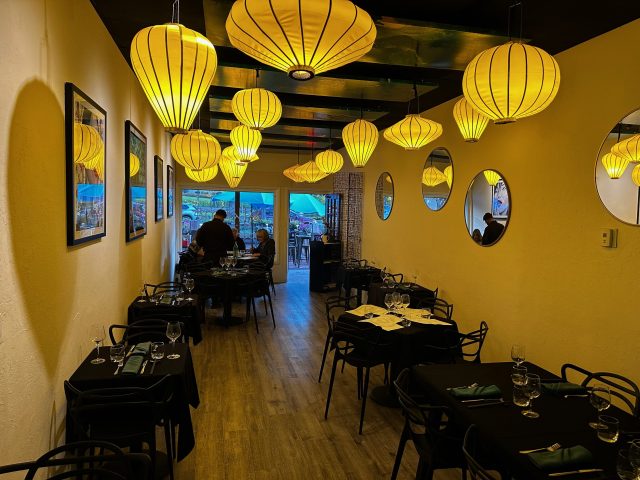
When you’ve reached Alkemē, you’ll notice that the restaurant’s name is subtitled “Heritage Cuisine Reimagined.” Alkemē’s website defines that concept as “Similar to the “Farm-to-Table” movement that recognizes knowing where your food comes from, Alkemē’s “Culture-to-Table” concept celebrates the culinary heritage rooted in the food we eat. Alkemē’s vision is to honor culinary roots by bringing to life ancestral recipes, stories, and memories of flavors combined with an innovative approach. If you love Asian cuisine and are motivated by the exploration of reimagined flavors, those words are enticing.
Alkemē is a beautiful space with bright, sunny colors on both the wall and hanging overhead in the form of paper lanterns. Round mirrors on one wall and framed artwork on another reflect the restaurant’s airy feel and somehow make the Liliputian space seem even larger. Visit the restroom and you’ll espy conical shaped hats named non la which are used to shield workers from heat or rain. Also hanging on the wall is a beautiful traditional Vietnamese silk shirt, the type of which Hue-Chan wears so glamorously.
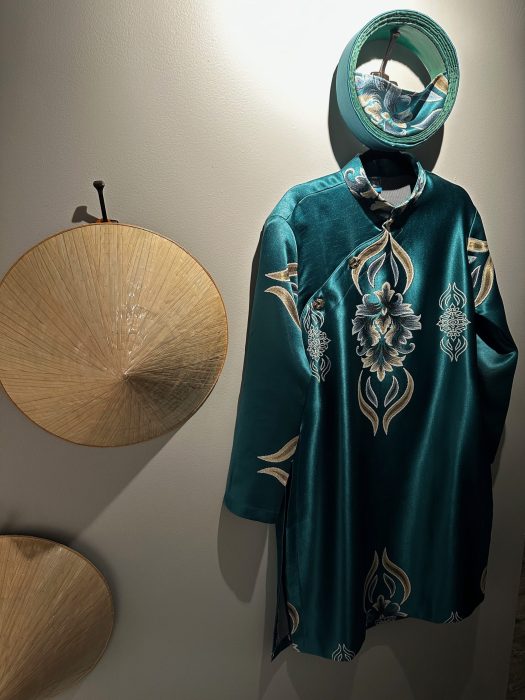
The menu apprises diners that “Chef-Owner Hue-Chan Karels and Executive Chef Erica Tai are reinterpreting heirloom recipes from their culinary roots of Vietnam, Taiwan, Korea, and Hawaii’s Pacific Rim to create dishes that are innovative yet steeped in tradition and culture.” There are actually three dining menus–an a la carte menu and three tasting menus, each offering five items. Our foursome ordered two of the three tasting menus and one a la carte item. Splitting dishes four ways doesn’t guarantee any one single diner will get a full impression from one or two bites, but when four of us discussed those bites, we achieved something of a consensus about what we liked and why.
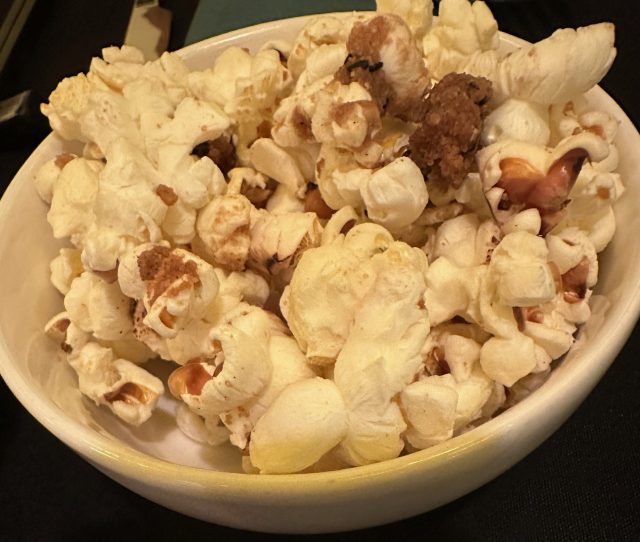
1st Visit: 19 October 2023
“Candy coated popcorn, peanuts and a prize. That’s what you get with Cracker Jacks“–That’s what consumers in the 1960s heard on television commercials for the caramel covered popcorn Americans have been enjoying for more than 120 years. Some culinary historians actually consider it the “first junk food.” Others will tell you it’s as American as hot dogs and baseball…and in fact, Cracker Jacks has a long association with baseball. The song “Take Me Out to the Ballgame” implores “buy me some peanuts and Cracker Jacks.” Because Cracker Jacks are such an integral part of Americana, we don’t often consider they may be enjoyed by consumers in other countries.
Alkemē’s five spice Cracker Jack popcorn is Cracker Jacks reenvisioned. Instead of caramel the consistency of lacquer, the popcorn is seasoned with five spice powder. In the west it’s generally accepted that the human tongue can discern only four different tastes and that all tastes in the dining experience are combinations of those four: sweet, bitter, sour, and salty. By contrast, the Chinese have long believed that the human tongue possesses a fifth taste sensation–one that can detect pungent foods. Chinese postulate that each of the five taste sensations corresponds to one of nature’s five elements: water, fire, wood, metal, and earth. Those elements are believed to exist in five spice powder. You’ll believe you can taste every one of those elements in Alkemē’s unique Cracker Jacks.
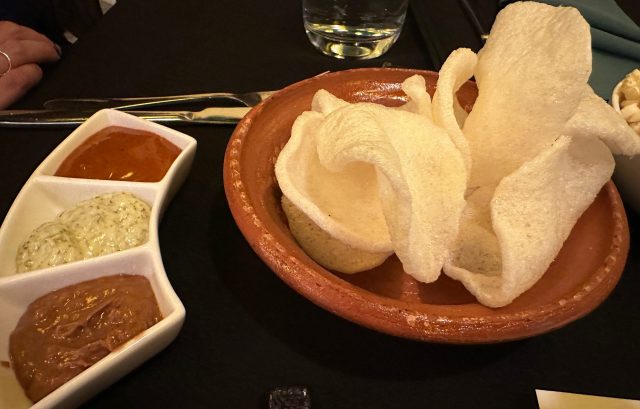
Sure they look like those biodegradable packing peanuts and even resemble them texturally, but prawn-flavored chips are hardly something with which you’d like to ship a package. Prawn chips are made by mixing prawns, tapioca flour and water. The mixture is rolled out, steamed, and sliced. To achieve maximum crispiness, raw chips are usually sun-dried before frying. This eliminates the moisture. Frankly, the chips themselves aren’t nearly as flavorful as oversalted, fatty American snacks.
That’s why Alkemē serves prawn-flavored chips with a trio sauce flight. The three sauces are a gochujang aioli, dill aioli and peanut sauce. Each sauce is terrific! Gochujang is is a savory, sweet, and spicy fermented red chili paste condiment that lends pungency to foods in which it is used. It’s a staple of Korean cooking and increasingly one of my favorite sauces. The peanut-hoisin sauce will remind you of the peanut sauce commonly offered at Thai and Vietnamese restaurants. Alkemē’s version has got a bit more punch and made the prawn-flavored chips livelier. The dill aioli makes a perfect dipping sauce for virtually every food. Its garlicky, lemony and pronounced dill flavors impart a bit of magic to every dish. Alkemē should bottle and sell these fantastic sauces!
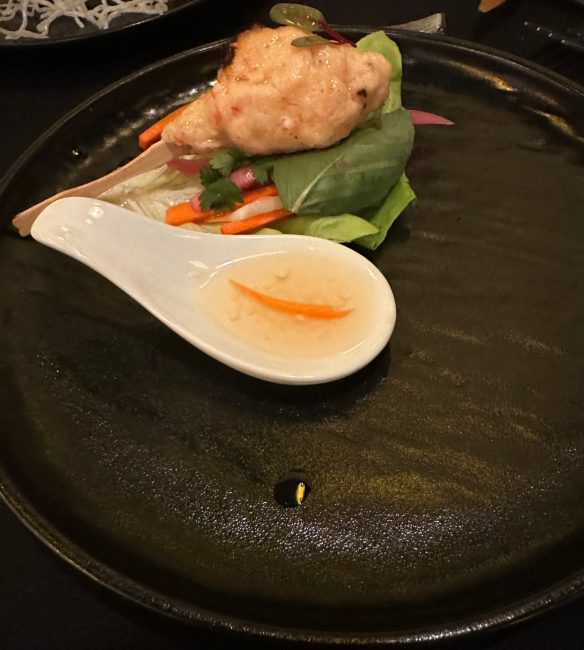
Wikipedia tells us “Dumplings may be any of a wide variety of dishes, both sweet and salty, in several different cuisines. They are either made from balls of dough or are small bits of food put into pastry, dough, batter, or leaves.” By this definition, Wikipedia has come up with a surprising list of dumplings. This list includes some real surprises. Add Alkemē’s dumpling to the list of dumplings that stretch that definition. In hundreds of visits to Vietnamese restaurants across the fruited plain, I’ve never experienced any dumpling presented like the Vietnamese Grilled Naked Shrimp Dumplings with Nuoc Cham (Vietnamese Dipping Sauce). If there’s any dough, pastry, batter or leaves enveloping the shrimp, it was lost on me. Maybe that’s where the “naked” part comes in.
As a grilled shrimp go, this one was probably very good. “Probably” is the operative word here because the shrimp (also an oxymoron) was so small that once it was cut into four pieces, we didn’t have much to go on. It was easy to immediately discern the grilled flavors, but where was the “dumpling” part. Maybe (by Wikipedia’s definition) it became a dumpling if we wrapped the accompanying greens around the shrimp. The nuoc cham (Vietnamese dipping sauce) was charactristically salty, sweet, and tangy with hints of umami. For my taste it could have inherited a bit more pungency from the fish sauce from which it was made. If anything, this dish proved a tasting menu split four ways may not be enough for true discernment and appreciation of a dish.
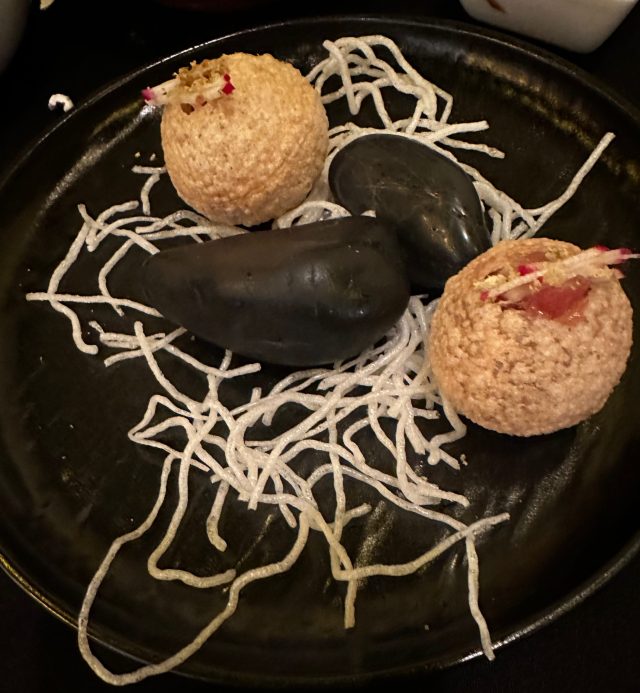
Several years ago, American “mainlanders” fell hook, line and sinker for poke, a Hawaiian dish of beautifully composed and expertly sliced cubes of marinated sushi grade fish tossed over rice and topped with Asian-inspired sauces. Some of us may think we’ve had every variation of poke there is then Alkemē inverts the poke, rendering a beautiful composed bowl into a beautiful reimagined dish reminiscent of “monkey balls.” The Hawaiian Off-The-Hook Poke in puri puri is tuna enrobed in a delicate batter. Atop the orb is puri puri sauce, a spicy and flavorful condiment that originated not in Asia, but in Angola. As with other dishes on the tasting menu, a four way split isn’t the optimal way to enjoy a dish diners might otherwise love.
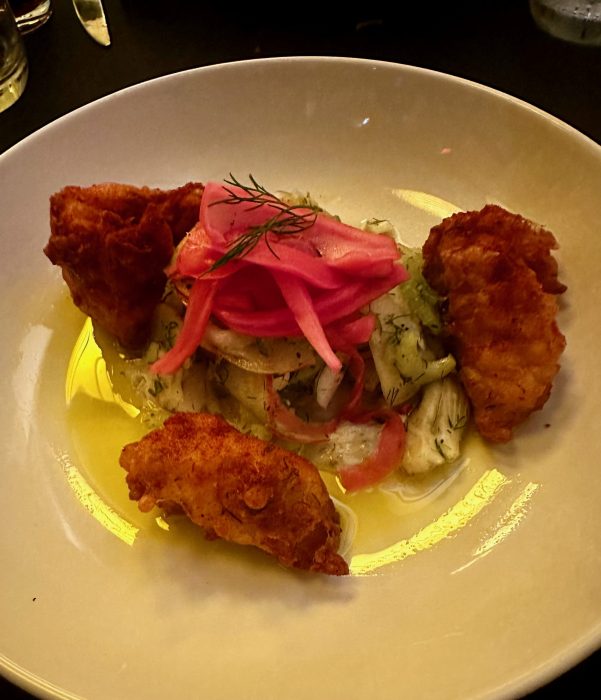
The crispy turmeric cod (Cha Ca) in a dill sauce, a specialty of Hanoi where a pan fried meaty white fish (usually catfish) is cooked with turmeric, dill, scallions, peanuts, shrimp paste and rice noodles. I’m not sure how closely Alkemē follows this traditional preparation, but am absolutely sure this was one of many highlights of our meal. The cod was indeed crispy, sheathed in a light and flavorful batter that easily gave way to the meaty white meat. Dill is the perfect sauce for the fish. It’s a complementary sauce, not one that changes the flavor profile of this magnificent dish. Also complementing the cod is pickled onions.
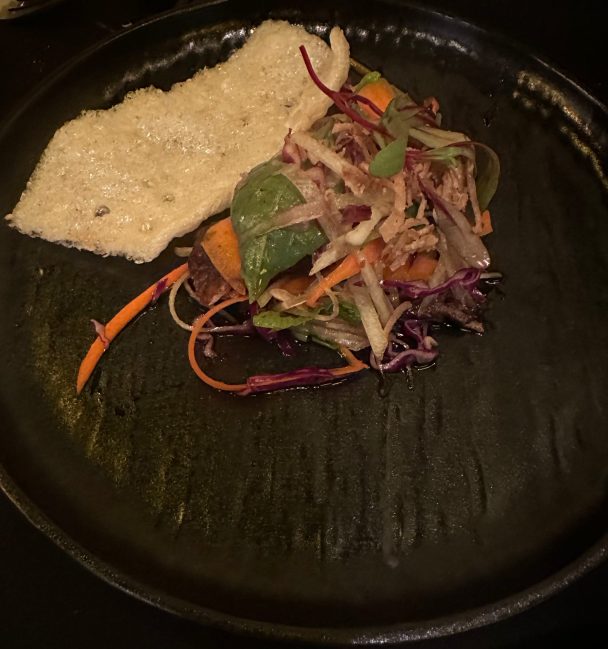
For years my Kim and I have been enjoying papaya salad at Thai, Vietnamese and Lao restaurants. It’s always replete with personality, invariably tantalizing our taste buds with a refreshing combination of spicy, sweet, salty, and sour elements. As with most papaya salads we’ve had, Alkemē’s version is just about appetizer (for two) size. Unlike other versions, Alkemē’s is grilled and it’s accompanied by lemongrass chile beef jerky. The papaya salad was fabulous, an exemplar of the diversity of the dish. Also fabulous is the lemongrass chile beef jerky. We’ve had beef jerky several times at Thai and Lao restaurants, but never before a Vietnamese version. Based on Alkemē’s version, it’s something we’d certainly love to see more often.

My favorite dish among the two tasting menus was the grilled rack of lamb with Asian chimichurri and orange-ginger-tamarind sauce. Prepared at medium-rare, the rack of lamb was moist, tender and absolutely delicious, ranking among the very best I’ve had. Splitting the lamb four ways, I somehow managed to secure the bone-in “Frenched” section. The propriety of using a lamb chop’s “handle” to pick up and eat lamb (particularly at upscale restaurants) has long been debated. None of my companions had any issue with me doing so.
This grilled rack of lamb was so wonderful–tender, moist, perfectly seasoned–I wanted to suck out the bone’s marrow. The lamb was accompanied by a picture-perfect ratatouille, sauteed vegetables stacked atop one another. Also on the dish was a single donut-shaped battered and fried brie. In that Vietnam was long occupied by France, Vietnam may be well advanced of other Asian nations in its acceptance of cheese. The preparation of the brie was worthy of French cuisine at its finest.
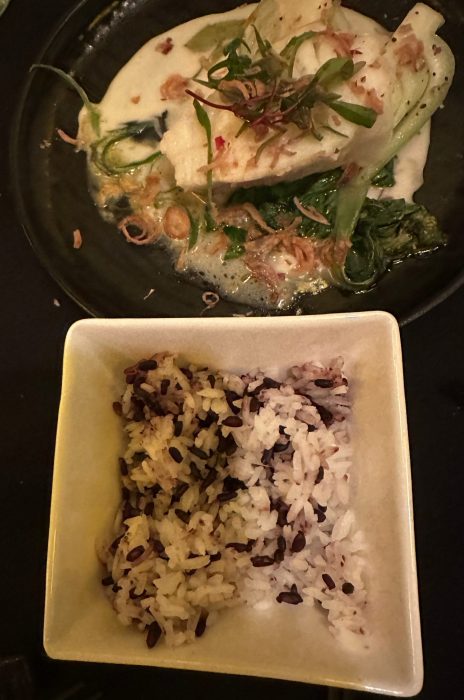
Also inspired by traditional French culinary wizardry is the Chilean sea bass a la nage (cooking in a well-flavored court-bouillon) with coconut milk and lemongrass served with forbidden rice. It amazed us at how the delicate flavor of Chilean sea bass (a tender-fleshed, mild, slightly sweet tasting fish often compared to a combination of cod and halibut) held up against the sweet, floral, nutty notes of coconut milk and the citrusy-ginger flavor of the lemongrass. From the green leaf blades to its lighter bulbous bottoms, the accompanying bak choy is superb accompaniment. So is the forbidden rice (so called because this rice was once reserved only for the wealthy and powerful to ensure their health and long life). It’s an interesting rice in that it combines an exotic purple-black hued rice with a long-grained white rice.
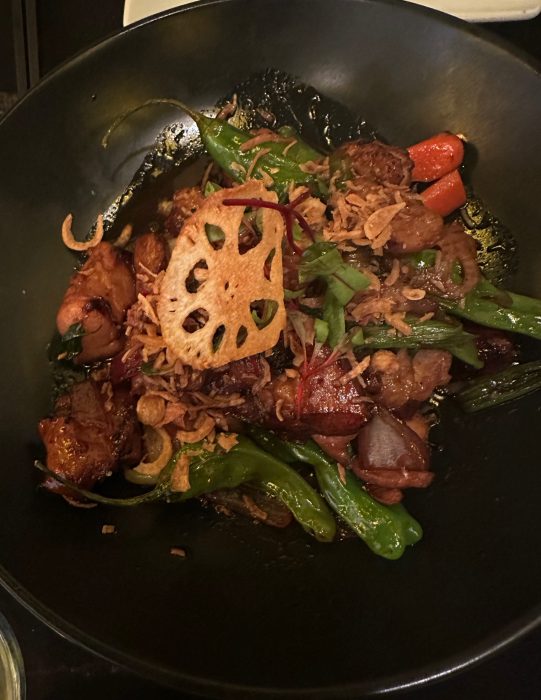
Even as we ordered two tasting menus, we surmised it might not be enough for the four of us. We had the foresight to order one additional main dish, Taiwaneese three-cup chicken. Popular culinary lore has it that the name “Three cups” refers to the original recipe calling for one cup each of soy sauce, rice wine, and sesame oil. Epicurious declared that “Something magical happens when you combine sesame oil, soy sauce, rice wine, garlic, ginger, basil, and chicken. This alchemy involves little more than infusing the oil with the aromatics before adding the chicken, deglazing with the liquids, and stepping back to let it braise and reduce.” Having experienced that alchemy at several Chinese restaurants, my declaration is more along the lines of “this is the best three-cup chicken dish Ive ever had.”
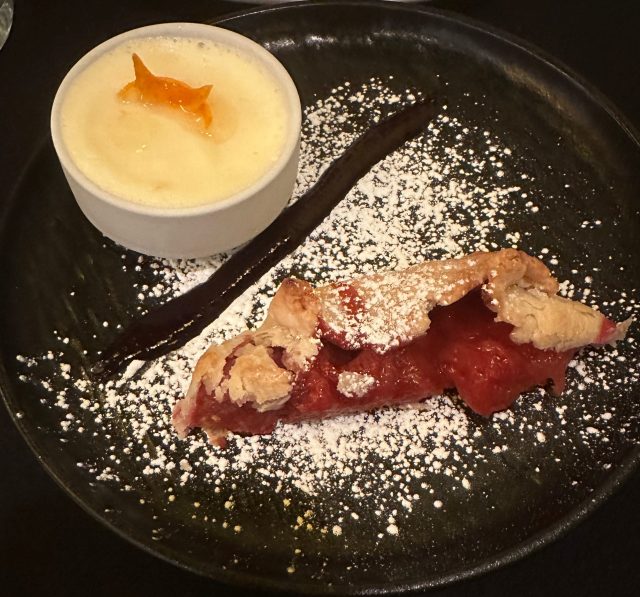
The first of our two desserts was a curiously named caramelized ginger summer stone fruit galette, limoncello ice cream and berry coulis. The galette was an intricate balance of sweet and tangy notes though discerning which specific stone fruits was somewhat beyond my pay grade. Even better than the galette was the limoncello ice cream. It’s rich and creamy, sweet and tangy and replete with a fresh lemon flavor.

The impact miso has on a dish is well understood when it comes to savory dishes. It would be dismissive to describe that impact in one word–umami, but that would be accurate. This delectable fermented paste brings an umami (savoriness) flavor to almost any dish, leaving your tastebuds actually begging for more. Thanks to miso and the browned butter, these brownies have layers upon layers of depth, flavor, and sweetness tempered by umami. Every component–from the miso orange whipped cream to the Sai Bon cinnamon chocolate bark–of this wondrous dessert contributes to a totality of deliciousness tha makes this dessert memorable
Our foursome agreed heartily with the sentiments of Cheryl Alters Jamison, agreeing that Alkemē had served us “One of the best meals being served anywhere.” Alkemē is an experience unlike any other in Santa Fe and one of the reasons some consider the City Different the “City Delicious.”
SECOND VISIT: 4 June 2024
In 2024, Alkemē was named a semifinalist for the James Beard Foundation’s “Best New Restaurant” award, a national honor that has never been bestowed upon any restauant in New Mexico (although in 2022, Santa Fe’s fabulous Zacatlan was also a semifinalist). In essence, Alkemē was among the top restaurants to launch in 2023 across the entire country. That’s a tremendous accomplishment considering much of the competition came from the country’s culinary hotbeds.

Accompanied by my Kim and our debonaire dachshund The Dude, we got to spend some time with Hue-Chan who wasn’t dismayed by not having been named a finalist. Instead, she’s more determined than ever for Alkemē to earn national recognition on every stage. That’s secondary to making each and every guest feel at home and thoroughly happy with their meals. Alkemē will accomplish some of this through special events that showcase the restaurant’s versatility. In June, Alkemē hosted “Sake Off The Beaten Path,” an elevated introduction to the world of sake. Alkemē is also inviting diners to discover Alkeme’s “Night Owl Happy Hour,” offering an ideal setting to relax with a drink and quick bite.
Hue-Chan is in her element at Alkemē. She is a peripatetic presence both inside the restaurant and on the patio. She flits from table to table to meet guests and ensure their Alkemē experience is a great one. The patio, by the way, is a wonderful venue for alfresco dining, especially as the sun drops down below rooftop level and the air cools. Dining on the patio is in personal space proximity, but we’ve always found patios a friendly refuge, especially if there are friendly dogs on the patio. The Dude got to meet a dachshund from Miami Beach with whom he enjoyed banter and merriment.

Several changes were apparent since my inaugural visit. An upcoming seasonal menu change (summer) will debut additional changes. Though my preference is to order menu items I haven’t previously had, I ordered two menu items I had had (crispy tumeric and Chilean sea bass) during our inaugural visit. My taste buds have a memory and that memory has been reminding me for months how wonderful those two menu items were…even though four of us shared every item and didn’t get much more than a bite or two of each.
Pâté became a staple of the Vietnamese culinary culture because of French colonialism during the period 1858 to 1954. At many Vietnamese restaurants (particularly those that serve banh mi), pâté is made using such Asian spices as black cardamom, star anise, clove, fennel seeds, cinnamon powder and even fish sauce. As with French pâté, it’s buttery, silky and wonderfully spreadable. We knew Alkemē’s Asian-inspired chicken liver pate would be wonderful–and it was.
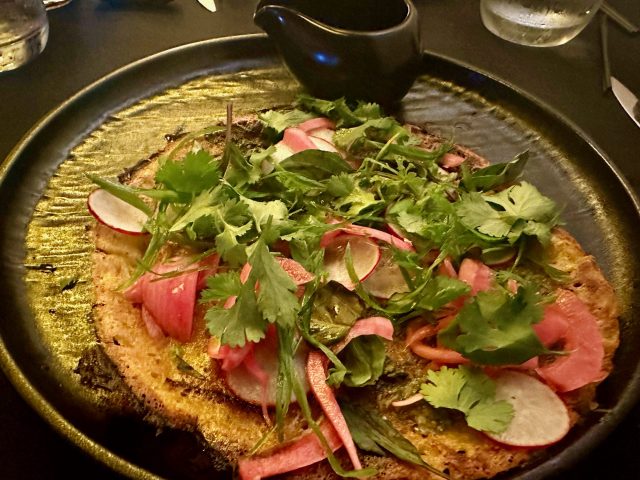
More than other Vietnamese pâté we’ve had it was redolent with Asian spices. Perhaps most prevalent was five-spice powder, one of my favorite seasonings. The chicken liver pate spread easily on the crostini, its creamy butteriness a perfect foil for the crispiness of the crostini. Also on the platter were Vietnamese pickles and roasted olives seasoned with preserved lemons and lemongrass. Perfectly pink pickled onions added color and tartness to the plate. This is a palate-pleasing, tongue-titillating platter of deliciousness that will prepare you for more.
For years, I’ve thought the proper pronunciation of Bánh xèo is “bun say oh.” That’s the way Anthony Bourdain also pronounced it during one of his three televised visits to Vietnam. During dozens of visits to dozens of Vietnamese restaurants, not one server has corrected me. Hue-chan did, but she did so in the most endearingly kind way conceivable. Alkemē’s version of Bánh xèo is a reimagined rendition of the French-inspired Vietnamese crepe. The word “banh” means “cake” in English, and “xeo” is the sizzling sound it makes when being fried in a pan! Instead of being folded over like an omelet, Alkemē’s rice flour crepe is open-faced, serving as the canvas for pork belly, seasonal vegetables and fresh herbs.
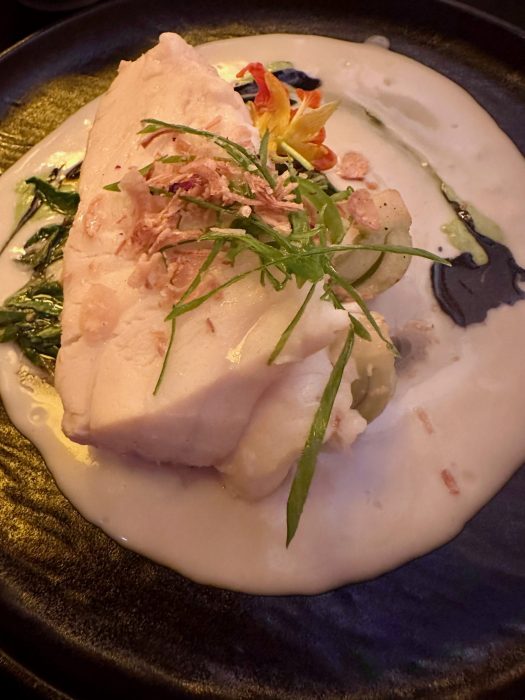
The pork belly, too, is interpreted somewhat differently. Instead of being sliced into thick, fatty bacon-like cubs, it’s shredded into tender tendrils of porcine perfection. The richness of the pork is a wonderful counterbalance to the herbs and seasonal vegetables, all made orchestrally concordant by the delightfully crispy banh. Alkemē’s Bánh xèo is not only beautiful–an open book of loveliness–it became (after only one bite) an exemplar of what a Bánh xèo should be. As Bourdain discovered in Vietnamese “all of the senses are engaged here” when you have a Vietnamese crepe
Much as I enjoyed the companionship of my Tulsa friends during my inaugural visit, the one menu item I most wish I had had a larger portion was the Chilean sea bass a la nange with coconut milk and lemongrass. Quite simply, this is one of the most delicious fish entrees I’ve ever had and a front-runner for the best dish I’ve had in 2024. You can read my description in the synopsis of my first visit above.
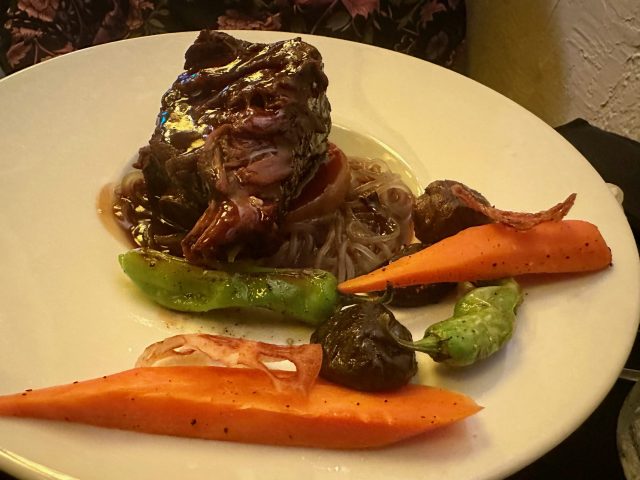
I was very intrigued by Alkemē’s Instagram photo and description of the Korean six-hour braised short rib: “Indulge in the rich and savory symphony of 6-hour braised Short Rib Adobo, a culinary masterpiece inspired by the vibrant flavors of Mount Pinatubo in the Philippines. Elevating Santa Fe’s dining experience, we bring the fiery essence of the Pacific Ring of Fire to your plate.” Mount Pinatubo “blew its top” in 1991, an event recognized as the second-largest volcanic eruption of the 20th century. It was an awe-inspiring sight still being talked about in the Philippines.
Similarly, my Kim and I are still talking about Alkemē’s six-hour braised short rib. Short ribs acquire the rich marbling of rib steaks with the deep beefy flavor of chuck roast. Beef short ribs are akin to the most flavorful, delectable, tender, soft pot roast. They’re among my carnivorous Kim’s very favorite foods. Alkemē’s version is braised with gochujang, the sweet, savory and spicy fermented Korean red chili paste. The six hour process renders the short rib so tender and so incredibly delicious, it will make grown men (except vegans and vegetarians) swoon. I especially loved the “bark” those slightly crispy areas developed by the chemical interaction of spices and smoke.
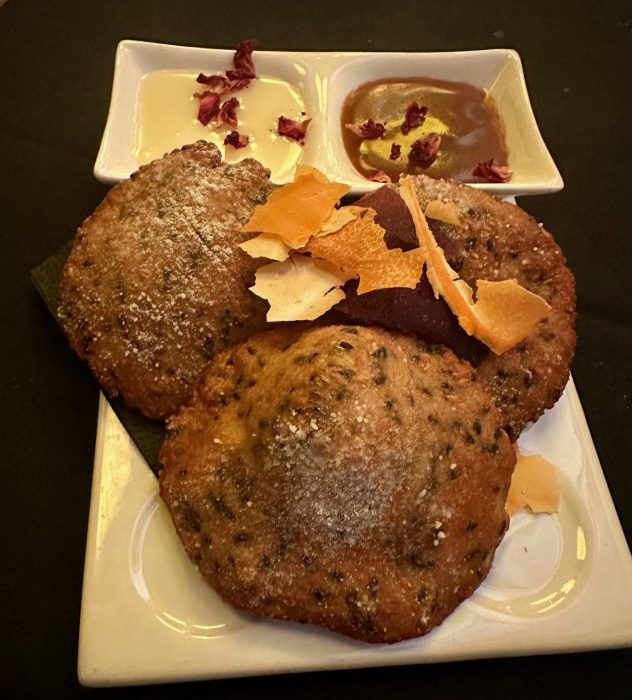
The Korean short ribs are served with a medley of vegetables and lotus root atop sweet potato noodles. Vegetables included sweet carrots and shishito peppers, the charred and blistered pepper with a very mild flavor (though when roasted they smell like green chile). The sweet potato noodles have a slight soy sauce influence and have a slippery, slightly chewy texture. They’re fun to contemplate and even more fun to eat.
My dessert choice was the Vietnamese hollow donuts with confection sugar and sesame sprinkles served with a duo of sauces: pandan white chocolate and green peppercorn carmel. Vietnamese hollow donuts are savory and often served with entrees such as pho. Unlike American donuts, they’re not crumbly and have more of a spongy consistency. They’re very light and airy courtesy of yeast which serves as a leavening agent. The two sauces are incredible. My Kim loved the green peppercorn caramel while my preference was for the pandan (a very fragrant plant with a sweet aroma) white chocolate.
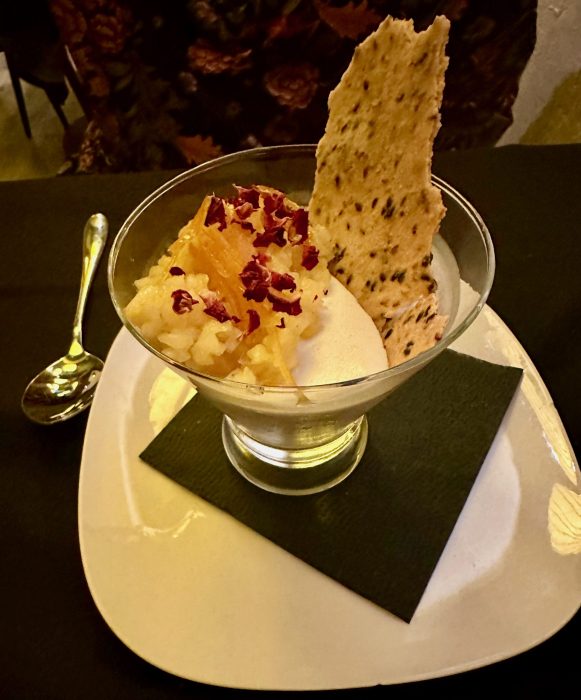
Just as wonderful is a lemongrass and coconut panda cotta with pineapple-giner chutney. This is a gluten-free vegan dessert as wonderful as any panna cotta we’ve ever had. Panna cotta may be an Italian dish, but it is interpreted in a unique and absolutely brillian manner at Alkemē. A single crispy papadum-like cracker studded with toasted, salty sesame seeds provides a savory contrast to the sweet components of the dish.
If possible, Alkemē was even better during my second visit. I can hardly wait for a third visit to see what alchemy this wonderful restaurant conjures.
Alkemē
227 Don Gaspar Avenue
Santa Fe, New Mexico
(505) 982-9704
Website | Facebook Page
LATEST VISIT: 4 June 2024
1st VISIT: 19 October 2023
# OF VISITS: 2
RATING: 27
COST: $$$$$
BEST BET:
REVIEW #1359
If you’re looking for a culinary gem in Santa Fe, Alkeme should be at the top of your list. With its Asian-accented menu and an inviting atmosphere, this restaurant delivers an unforgettable dining experience. My wife and I were drawn in by glowing reviews and decided to make reservations—and we were not disappointed.
The food is nothing short of exceptional: delicate, innovative, and bursting with flavor. Every dish is a masterpiece, showcasing creativity and precision. The service is equally stellar, with a staff that strikes the perfect balance between attentiveness and warmth. Whether you’re a local or just passing through, Alkeme promises a meal that will leave you impressed and eager to return.
I couldn’t agree with you more. Alkeme is a unique restaurant, one of the very best in the Southwest. In 2024 it was named a James Beard Foundation Best New Restaurant semifinalist. It’s certainly worthy of all the accolades and honors that have been piling in. Chef-owner Hue-Chan Karels and executive chef Erika Tai have created not only a fabulous menu, but a memorable dining experience you can’t find anywhere else.
2 weeks ago, I went and got the seafood based tasting menu. It is an exceptional restaurant, one of Santa Fe’s very best. Food is excellent, inventive, and well thought it. The service was equally superb. It’s pricey but worth it.
It’s not just one of Santa Fe’s or New Mexico’s very best. Alkeme can compete on any major metropolitan area’s culinary arena. It’s a fantastic restaurant. I hope you got to meet Hue-chan. She’s quite a character in all the best sense of the word.
Lol. Yes, she gave my wife and I a quick tour of the art work on the walls and what the meaning of it was. She’s a wonderful person.
That is a great picture of Hue-Chan with The Dude! And am I mistaken, or is this The Dude’s first photo appearance in your blog??
Good question. I imagine The Dude has probably shown up in the background of one or two photos. Unlike his dad (me), he likes his picture taken and doesn’t have a shy bone in his body.